|
|
Post by Dave Homewood on Jun 26, 2019 0:19:42 GMT 12
Here is a challenge, does anyone recognise these airmen? 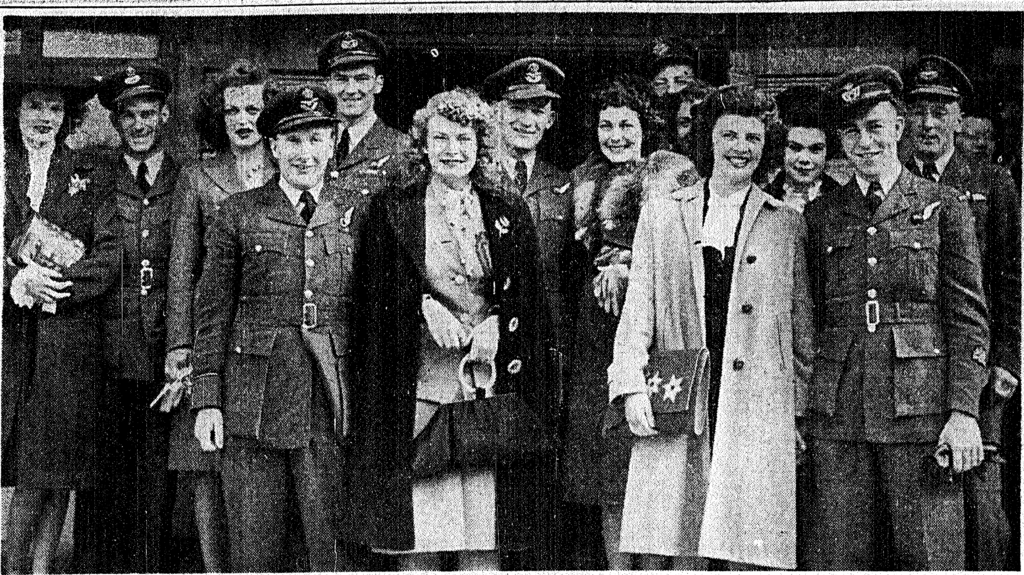 TO MAKE THEIR HOMES IN NEW ZEALAND: Dominion airmen photographed after meeting their wives and fiancees, some of a party which arrived from the United Kingdom and Canada recently. NEW ZEALAND HERALD, 5 MAY 1945 |
|
|
|
Post by Dave Homewood on Jul 20, 2019 23:26:13 GMT 12
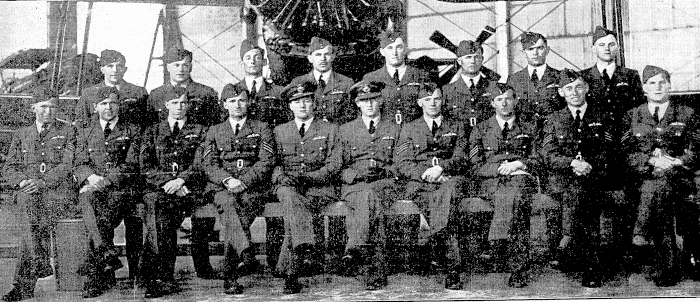  That reads: PASSING-OUT DAY AT WIGRAM.- The passing-out inspection of officers ad airmen pilots of No. 13 Course of No. 1 Flying Training School at Wigram was carried out yesterday by Wing Commander G. S. Hodson. The group passed out. Back row, Sergeant-Pilots J.F. Carrick, G.V. Key, R.H. Clifford, G.G. Davis, D. L. McGregor-MacDonald. J. M. S Ross, W.D.A. McLeod, and R.H.Alington. Front row: Sergeant Pilots G.T. Kimberley, H.N. Goodall, C.H. Douglas, J.A. Neiison. Acting-Pilot Officers C. Stewart and N. L. R. Cowan. Sergeant Pilots N. F. Dixon, L. R. Hewith, H. T. Francis and M. M. Shand. PRESS, VOLUME LXXVI, ISSUE 23031, 28 MAY 1940 Some things that strike me about this photo are this: - Sergeant-Pilot J.M.S. Ross was John Macaulay Sutherland Ross, later Squadron Leader, and author of the Official History volumes Royal New Zealand Air Force and Chaplains.- Sergeant-Pilot M.M. Shand was Michael Moray Shand, later a Battle of Britain pilot and a Great Escaper. - What is the little four bladed propeller looking thought seen in the background attacked to or near the Vickers Vildebeest/Vincent's port wings? Was that part of a drogue towing add-on? - And what is the dark looking aeroplane in the left rear of the photo, sans wings? I cannot place it. |
|
|
|
Post by davidd on Jul 22, 2019 10:47:18 GMT 12
The little 4-bladed prop is part of a drogue winch, and this type of winch in NZ service was usually attached to a Fairy Gordon, or a Vickers Vincent/Vildebeest. Higher speed aircraft usually had an electric winch (Hudson, Catalina, Avenger). Single seat fighters, etc, normally used "banner" targets (think Mustang, possibly Vampire), or was equipped with a simple drogue attached to rear fuselage without any winch being necessary (think Kittyhawk). A special launching technique was used with last-mentioned method, with towing cable being layed on ground in such a way that the drogue was yanked into the air from a standing start, to avoid damage to drogue, and could be released near airstrip prior to landing. One of 42 Sqdn's Dakotas (NZ3546 I think) from the early 1960s was equipped with what looked like JATO bottles on its rear fuselage, I think these could be wound in and out at will by internal winch. Skyhawks and Strikemasters were also capable of towing targets so far as I know, possibly from underwing units; no doubt our local experts will put me right on this!
I think the dark-looking aircraft in rear of photo (left rear) is a Vincent/Vildebeest, the rather widespread upper wing centre section seems distinctive to me, as well as shape of nose curving down, just to left of Sgt Pilot Carrick's head. Pilot's cockpit is partially disguised behind some inner interplane struts. What appears to be a windscreen on extreme left may be the dual-control conversion incorporated in may of these aircraft.
David D
|
|
|
|
Post by Peter Lewis on Jul 23, 2019 20:07:52 GMT 12
One of 42 Sqdn's Dakotas (NZ3546 I think) from the early 1960s was equipped with what looked like JATO bottles on its rear fuselage, I think these could be wound in and out at will by internal winch. Arse-end view of NZ3546 showing target towing installation. Note plexidome on rear door so the operator could keep an eye on things. 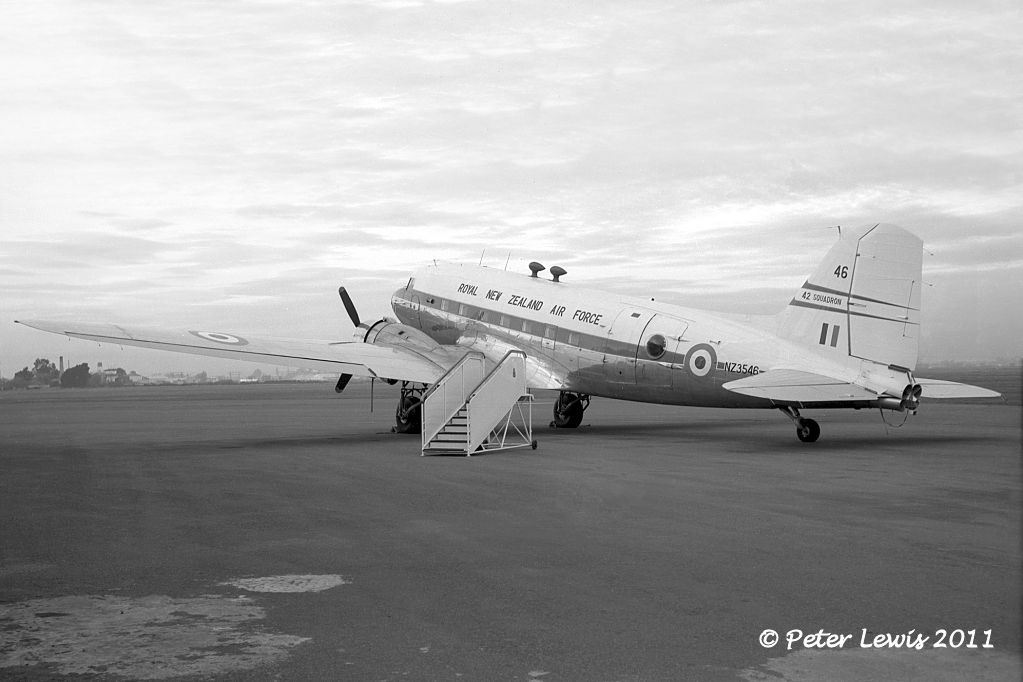 |
|
|
|
Post by pjw4118 on Sept 4, 2019 13:49:02 GMT 12
|
|
|
|
Post by baronbeeza on Sept 4, 2019 14:02:24 GMT 12
|
|
|
|
Post by pjw4118 on Sept 25, 2019 15:23:58 GMT 12
|
|
|
|
Post by Deleted on Jan 21, 2020 14:00:57 GMT 12
Photo of No 8 BR SQN March 1945 (copywrite Archives New Zealand). Would anyone be able to identify the following airmen in the photo; HAMILTON J.D. (415528), ALDRIDGE K.F. (4213795), MENCE A.A. (4229480)?  No 8 SQN No 8 SQN by Phil Harding, on Flickr |
|
|
|
Post by pjw4118 on Mar 22, 2020 13:51:25 GMT 12
75 Squadron Ohakea Jan 1947 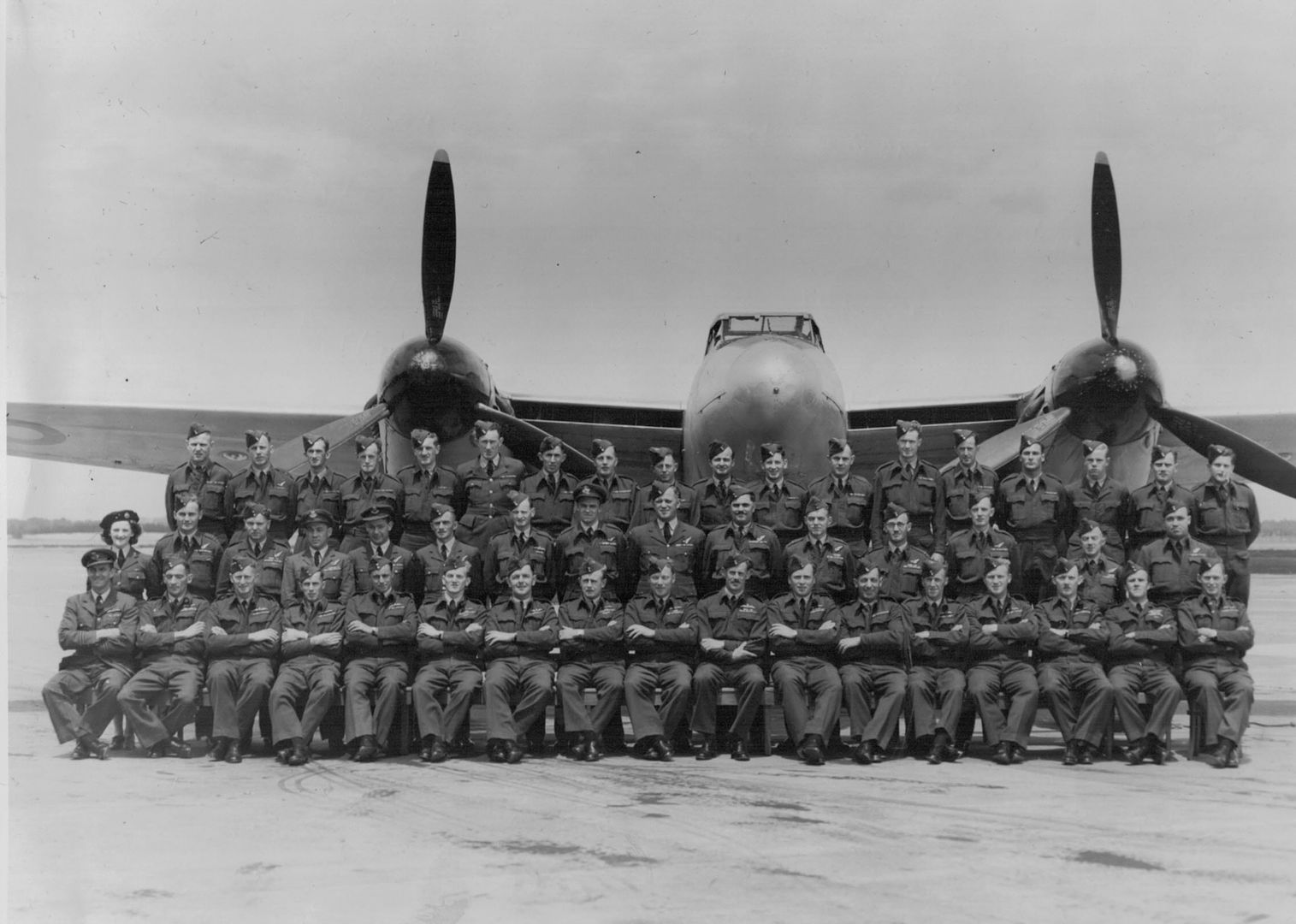 |
|
|
|
Post by baronbeeza on Mar 28, 2020 15:55:03 GMT 12
A modified B&W pic of what I believe is 16 Squadron. I will add more details when I find them. Peter Sheppard is 2nd row from rear, 3rd from left. 16 Squadron 1945, Bougainville Papua New Guinea. Peter Sheppard 3rd row back 3rd from left.   |
|
danielrarity
Leading Aircraftman
 Film-maker from Blenheim. Making movies with planes
Film-maker from Blenheim. Making movies with planes
Posts: 4 
|
Post by danielrarity on Apr 6, 2020 16:42:23 GMT 12
|
|
|
|
Post by 30sqnatc on Apr 6, 2020 17:56:36 GMT 12
I never realised RNZAF used khaki forage caps during WW2.
|
|
|
|
Post by wanganui on Apr 7, 2020 5:48:45 GMT 12
They didn't, issued and worn in the Pacific by RNZAF officers and OA was a pale blue side cap made from shirting fabric.
|
|
|
|
Post by Dave Homewood on Apr 7, 2020 9:15:49 GMT 12
Agreed, the caps were pale blue.
|
|
|
|
Post by davidd on Apr 7, 2020 12:33:41 GMT 12
The cotton pale blue F/S caps were introduced in about August 1944, as replacements for the rather hot and prickly BG serge F/S caps. Similar caps were manufactured postwar for use in tropical countries, including Fiji and Singapore/Malaya, including Air rank caps with additional piping (dark blue?).
David D
|
|
|
|
Post by 30sqnatc on Apr 7, 2020 20:31:17 GMT 12
Thanks that is actually what I thought. I had a modern one given to me as a youngster in Singapore in late 1960s by a 41 Sqn member.
|
|
|
|
Post by davidd on Apr 8, 2020 12:55:21 GMT 12
The CO of 16 Squadron on its last Pacific tour was S/L P S (Paul) Green, DFC. That is him in the front row, centre, where COs traditionally placed themselves, with his flight commanders flanking him (F/Ls E L ("Butch") Avery and V C Bargh, DFC, or D I Gray?) His intelligence officer ("spy") (F/O F R Bassett) would also be lurking around on that front row - he would be the only one without a pilot's badge, but unfortunately by this late stage, the metal version of this badge was the norm, and it is rather difficult to spot in photos such as this, being quite small.
David D
|
|
|
|
Post by Dave Homewood on Apr 8, 2020 13:12:40 GMT 12
It is indeed Vic Bargh.
And top right in the blue FS hat is Bryan Cox.
|
|
|
|
Post by fwx on Jun 24, 2020 17:53:03 GMT 12
In the October 2000 issue of the NZ Bomber Command Assn newsletter, this photo and note was published: 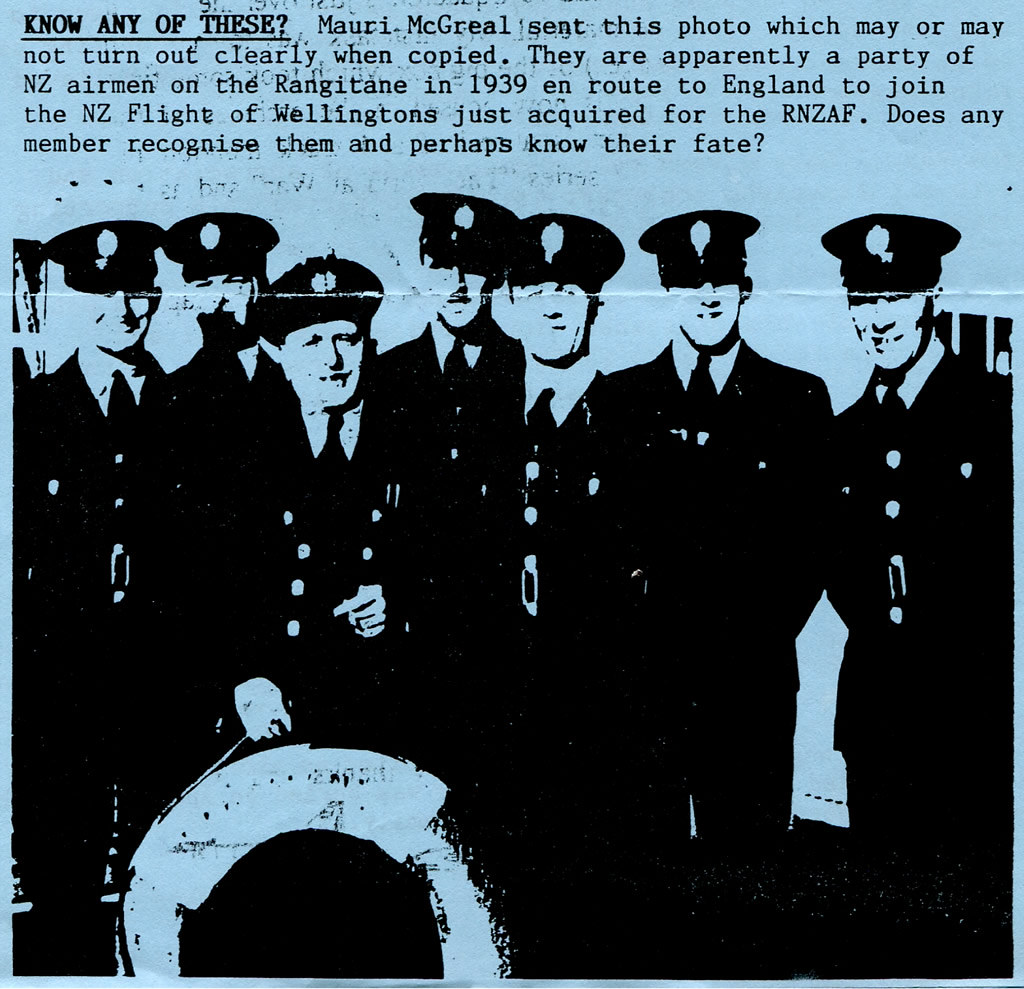 It appears to be the ship's captain (front) with the six Wireless specialists who sailed to England on the Rangitane in January 1939 to train in preparation for the New Zealand Squadron's first Wellington ferry flights, as reported in the newspapers of the time: 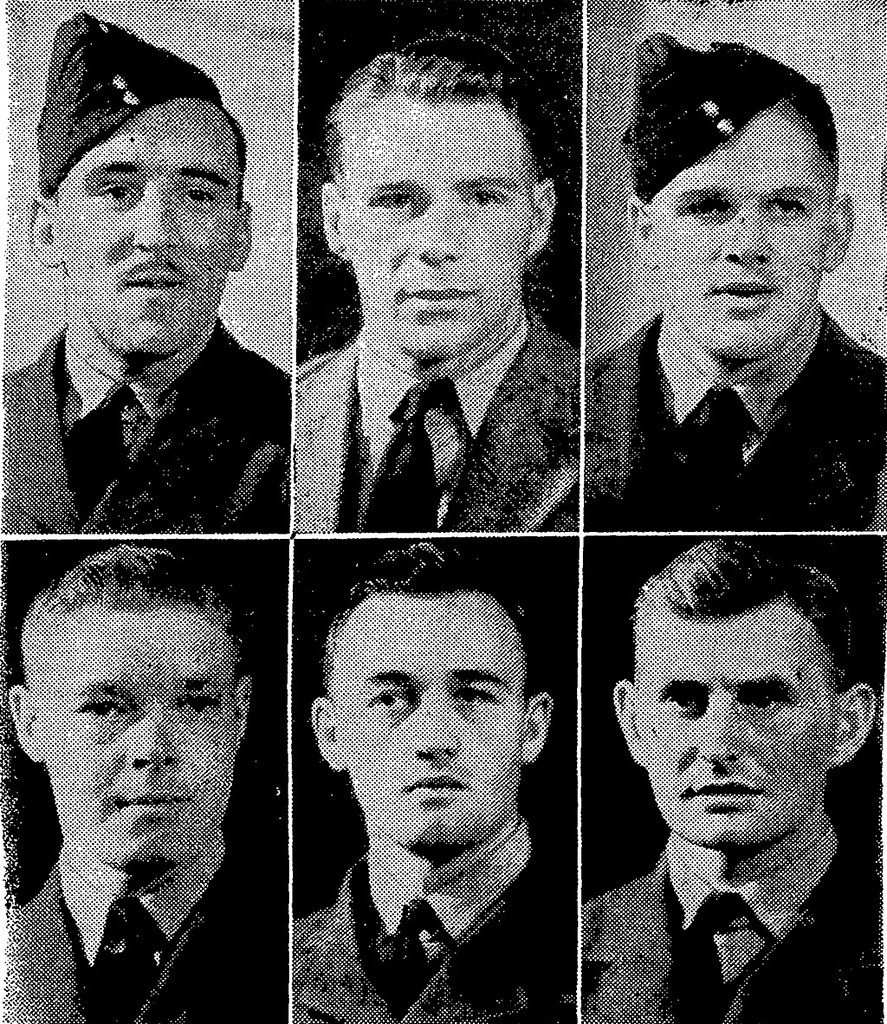 “Six wireless operators of the Royal New Zealand Air Force, who are proceeding to the United Kingdom to join the Vickers Wellington bombers which are to be flown from England to New Zealand. Top row, from left, Messrs. C. B. G. Knight, R. A. J. Anderson, J. A. Landridge*. Bottom row, Messrs. D. C. McGlashan, E. P. Williams, and J.T. White.” * Jack Harry Langridge. - Evening Post, 11 January 1939. Firstly, I would love to find the original or a better copy of the top photo - has anyone come across it? Secondly, the uniform they are wearing - none of them were officers (by the time they reached Marham in July they held ranks of either AC1 or LAC) but all appear to be wearing officers caps?? Was this some kind of dress uniform or No. 1s that they were allowed to wear overseas? Thanks for your help, cheers, Chris P.S. Regarding Mauri McGreal's queries, L-R: White, McGlashan, (Captain of the Rangitane?), Knight, Williams, Langridge, Anderson; and all but Langridge survived the war. |
|
|
|
Post by davidd on Jun 25, 2020 10:47:23 GMT 12
The airmen are all wearing the standard OA (Other Airmen, equivalent to Army's "Other Ranks") SD (Service Dress) cap of the time, known irreverently as the "cheese cutter", because of the sharp outer edge of the crown, which was in fact formed by a stiff wire inset. Unfortunately I am not aware of the exact date of introduction of the OA FS (Field Service) cap (also known as "Side cap", "Fatigue cap", or incorrectly as the "Glengarry"), but it may have been in 1938/39 period. The standard OA SD cap had the shiny patent leather peak of course, as they were when re-introduced for RNZAF airmen in about 1950. Pre-war airmen issued with the OA SD cap were ordered to hand them back to the Station Clothing Store in about April 1940, with promise that they would be returned after "the emergency" (WW2!), but that promise was not really kept.
Believe it or not, when the OA SD cap was first introduced by RNZAF (possibly in about 1928/29, perhaps by time of the arrival of Charles Kingsford Smith at Wigram), it was fitted with an RAF OA cap badge, as the NZPAF of the time had no such badge because nobody thought they needed one! You can occasionally spot these badges being worn this way in photographs from that period, if they are sharp enough, as the RAF badge is much more distinctive at any distanced than the RNZAF's later "alphabet soup".
Incidentally most of these six airmen later volunteered for flying duties and became Wireless Operator Air Gunners, etc.
David D
|
|



